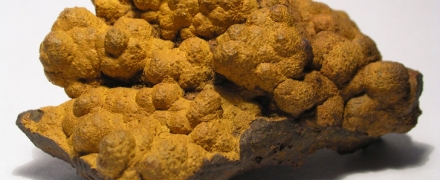open 10 am - 7 pm
laboratory is closed
Goethite and hydrogoethite

Of course, we all know about such an ore mineral as goethite, which forms dense aggregates and is widely used as an ornamental stone. It also has a very long history of use in this capacity, dating back to prehistoric times, when numerous magical properties were attributed to it. But far from everyone has heard about the use of goethite and, even more so, hydrogoethite (better known as limonite). Limonite is often present in turquoise used in cabochons. It gives some charm to such inserts, but does not at all raise their quality and cost characteristics. Also, limonite can be found in the "tiger's eye", where its films give the stone a golden hue, without which the parallel fibrous aggregate of quartz would be a gray, inconspicuous stone. Interestingly, both goethite and even limonite, which form dense overflow masses, are used in the production of decorative cabochons and even faceted cuts. True, limonite used for cabochons often contains bright “stars” of supergene minerals, such as malachite, azurite, crocoite, pyromorphite, and a number of others. Such cuts are the lot of amateurs and collectors; these two minerals should not be seriously considered as independent ornamental or jewelry and ornamental stones. In addition, in the process of cutting these minerals, it is often necessary to use various methods of sizing and surface coating of finished inserts. Ornamental goethite and limonite on the territory of the former USSR is known in a number of manifestations of Kazakhstan, in the iron ore deposits of Krivoy Rog and the Kursk Magnetic Anomaly, and of course the main source of ornamental goethite and hydrogoethite is the Bakala iron ore deposits (Chelyabinsk region).
В геммологической практике бывают весьма увлекательные случаи с диагностикой ювелирных вставок
Но помимо редкости цвета и высокой стоимости таких камней, многие розовые камни выделяются одной замечательной особенностью – они проявляют плеохроизм, то есть в зависимости от положения осмотра камня он может иметь дополнительные оттенки – оранжевый или пурпурный.
Currently, gemstones are produced by two fundamentally different technological methods - the High Pressure - High Temperature method (“HPHT”, High-pressure & High-temperature) and the Chemical Vapor Deposition (“CVD”, Chemical vapor deposition) method. The "HPHT" method is the most tested classical synthesis method, which can be used both carbon deposition on diamond from flux melts and catalytic reactions. In "CVD" synthesis, diamond growth occurs on a seed during carbon deposition mainly from a gaseous medium at relatively low temperatures and pressures.
Jewelry and precious stones are just such a category of goods, when buying which you need to pay attention to many criteria.
Sogdianite is a rather rare mineral and more often it can be found as a collection material (moreover, in systematic collections), and it is extremely rare in jewelry.






